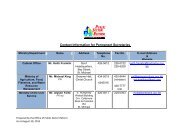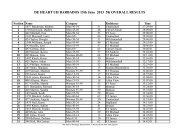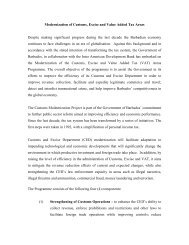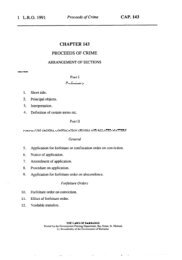The 2008 Agricultural Digest - Ministry of Agriculture and Rural ...
The 2008 Agricultural Digest - Ministry of Agriculture and Rural ...
The 2008 Agricultural Digest - Ministry of Agriculture and Rural ...
- No tags were found...
Create successful ePaper yourself
Turn your PDF publications into a flip-book with our unique Google optimized e-Paper software.
Minister’s Foreword 1Editorial Note 2Overview <strong>of</strong> <strong>The</strong> <strong>Agricultural</strong> Sector <strong>2008</strong> 3Rethinking <strong>The</strong> Role <strong>of</strong> <strong>The</strong> <strong>Agricultural</strong> Sector 4-14“Challenges Of <strong>The</strong> 21st Century” – By Rommell Hippolyte,Economist (<strong>Ministry</strong> Of <strong>Agriculture</strong>)Outlook for 2009 15CONTENTS<strong>The</strong> Barbados Sugar Industry 16Trade Statistics 16Figure 1: Barbados Raw Sugar Exports 2003-<strong>2008</strong> 16<strong>The</strong> Barbados Cotton Industry 16Table 1 - Cotton Statistics 16<strong>The</strong> Barbados Food Crop Sector 17Livestock <strong>and</strong> Dairy Sectors 17Fisheries Sector 18Table 2- Fish L<strong>and</strong>ings By Type (Tonnes) 2003-<strong>2008</strong> 18Food Trade 19Table 3-Barbados’s <strong>Agricultural</strong> Food Bill (2007 And <strong>2008</strong>) 19Rainfall In <strong>2008</strong> 20Figure 2: Barbados Rainfall By Month (2007 And <strong>2008</strong>) 20Figure 3: Rainfall By Parish In Barbados (2007 And <strong>2008</strong>) 20<strong>Agriculture</strong> Upclose 21Statistical Appendix 22-27Table 1 – Production Of Selected <strong>Agricultural</strong> Commodities 22Table 2 – Average Wholesale Produce Prices For <strong>2008</strong> 23Table 3 – Average Retail Produce Prices For <strong>2008</strong> 24Table 4 – Import Data For Selected Fresh <strong>Agricultural</strong> Commodities (Kgs) 25Table 5 – Total Export Data For Selected Fresh <strong>Agricultural</strong> Commodities (Kgs) 26Table 6 – Monthly Rainfall Data By Parish For <strong>2008</strong> (Millimeters) 27
MINISTER’SFOREWORDSenator, <strong>The</strong> Honourable Haynesley BennMinister <strong>of</strong> <strong>Agriculture</strong> <strong>and</strong> <strong>Rural</strong> DevelopmentOver the past decade there has been a dearth <strong>of</strong> agricultural information in Barbados. A call hasbeen made from many quarters for there to be more consistent information available on whichwell-informed decisions can be made to address the various issues that confront the sector.Formerly, agricultural information could have been sourced through the Barbados MarketingCorporation’s BASIS Reports, with production data being made available through the annualpublication AGRIVIEW that was produced by the <strong>Ministry</strong> <strong>of</strong> <strong>Agriculture</strong> <strong>and</strong> <strong>Rural</strong> Development.<strong>The</strong>se publications were <strong>of</strong> great support to farmers providingthem with pertinent information, including the latest trendsin production, trade, prices <strong>and</strong> credit to the sector.This information went a long way in assisting the farmingcommunity with its planning, helping it not only to betterunderst<strong>and</strong> the changes occurring within the sector, butalso assisting the more industrious with capitalising on anyopportunities that may have been presented in thedomestic market. However, the production <strong>of</strong> these publicationsceased with the last volume <strong>of</strong> AGRIVIEW being produced <strong>and</strong>published in 1998.It is therefore a great honour <strong>and</strong> indeed a pleasure for meas the Minister <strong>of</strong> <strong>Agriculture</strong> <strong>and</strong> <strong>Rural</strong> Development tointroduce to you the “<strong>Agricultural</strong> <strong>Digest</strong>”, the newest agriculturalpublication created by the <strong>Ministry</strong> to fill the voidthat was left by the defunct AGRIVIEW publication. I amsure that the launch <strong>of</strong> this publication, will address theinformation void by catering to the range <strong>of</strong> information needs<strong>of</strong> the Barbadian public, whether local farmers, individualsdesirous <strong>of</strong> undertaking research, or those merely interestedin developments related to the domestic sector. Unlike previouspublications, the <strong>Agricultural</strong> <strong>Digest</strong> provides not only datapresented in the form <strong>of</strong> tables, but also seeks to assist with theanalysis <strong>of</strong> data through the presentation <strong>of</strong> well constructeddiagrams <strong>and</strong> informative text.One addition that I am very pleased to note is the inclusion<strong>of</strong> a topical research article. This year’s Volume <strong>of</strong> the Publicationprovides a most interesting <strong>and</strong> appropriate research articleon rethinking the role <strong>of</strong> agriculture in the country’s economicgrowth <strong>and</strong> development. This article suggests that given emergingnational trends such as rising food prices <strong>and</strong> increased foodimports, the importance <strong>of</strong> local agriculture to the economy<strong>of</strong> Barbados must be revisited.I trust that this article will stimulate the reader to re-think the role<strong>of</strong> the agricultural sector in Barbados <strong>and</strong> will invoke nationaldiscussions on how we as a nation can reposition the sectorso that it fulfils its m<strong>and</strong>ate not only <strong>of</strong> food security,but also <strong>of</strong> poverty alleviation.I wish to take this opportunity to extend my sincere appreciation tothe staff <strong>of</strong> the <strong>Agricultural</strong> Planning Unit for taking the initiative toproduce such a well-designed <strong>and</strong> informative publication.Volume 1<strong>Agricultural</strong> <strong>Digest</strong> | <strong>2008</strong>1
EDITORIAL NOTE<strong>The</strong> <strong>Agricultural</strong> <strong>Digest</strong> is the <strong>Ministry</strong> <strong>of</strong> <strong>Agriculture</strong>’s journal <strong>of</strong> annual statistical data. This publicationreplaces the previously produced “Agriview”, which was last issued in 1998.Prepared <strong>and</strong> published by the <strong>Agricultural</strong> Planning Unit <strong>of</strong> the<strong>Ministry</strong> <strong>of</strong> <strong>Agriculture</strong>, this publication provides data <strong>and</strong> someanalysis on the performance <strong>of</strong> the various sub-sectors during thepreceding year, as well statistics on agricultural trade <strong>and</strong> rainfall.An interesting addition to this new publication is the Up-Closesection, which highlights the views <strong>of</strong> a member <strong>of</strong> the farmingcommunity on developments within the agricultural sector, aswell as their related accomplishments.This publication responds to the numerous requests received bythe <strong>Ministry</strong> on a daily basis for agricultural statistics. We in the<strong>Ministry</strong> thank you for your patience <strong>and</strong> underst<strong>and</strong>ing while wesought to improve our statistical system <strong>and</strong> the quality <strong>of</strong> servicewe provide to our stakeholders.We will continuously strive to respond to the needs <strong>of</strong> the farmingcommunity <strong>and</strong> remain committed to providing relevant <strong>and</strong>up-to-date information, which is so necessary to assist us in ourplanning <strong>and</strong> decision-making.Our appreciation is extended to all those persons who providedus with the statistical information required to facilitatethe preparation <strong>of</strong> this journal, as well as to all <strong>of</strong> those who in anyway contributed to the preparation <strong>of</strong> this <strong>Agricultural</strong> <strong>Digest</strong>.2<strong>Agricultural</strong> <strong>Digest</strong> | <strong>2008</strong>Volume 1
OVERVIEW OF THEAGRICULTURAL SECTOR <strong>2008</strong>During <strong>2008</strong>, the agricultural sector’s contribution to Gross Domestic Product was 2.8 percent 1 .<strong>The</strong> <strong>Ministry</strong> <strong>of</strong> <strong>Agriculture</strong> had anticipated an improved performance from over the previous year.It was expected that the farming community would have intensified its production efforts in order tocapitalise on the persistent trend <strong>of</strong> rising agricultural prices in the domestic market. Instead, the first half<strong>of</strong> the year saw the sector being severely hampered by the root causes which were associated withglobal price increases <strong>of</strong> key agricultural commodities namely oil, fuel <strong>and</strong> corn. <strong>The</strong> increase in oil<strong>and</strong> fuel prices directly impacted some <strong>of</strong> the larger-scaled farming operations in Barbados which areenergy intensive. <strong>The</strong> increased price <strong>of</strong> corn, which is a major input in the production <strong>of</strong> livestock feed,resulted in a hike in the cost <strong>of</strong> producing local meats.Dem<strong>and</strong> for agricultural produce on Barbados during the reviewperiod, suffered some fall-<strong>of</strong>f on the dem<strong>and</strong> for locally producedcommodities. Consumers seemed to be more vigilant <strong>of</strong>their reduced purchasing power in the face <strong>of</strong> economy-widerising prices. <strong>The</strong> reduced dem<strong>and</strong> for local agricultural produce,coupled with the increased cost <strong>of</strong> production <strong>of</strong> all domesticagricultural endeavours in Barbados, consequently resultedin the departure <strong>of</strong> some <strong>of</strong> the smaller farmers from theirrespective industries as they were unable to remain competitive.Throughout the latter part <strong>of</strong> <strong>2008</strong> the international prices<strong>of</strong> fuel, oil <strong>and</strong> corn had changed their trajectory <strong>and</strong> hadregistered consistent declines. However, the pass-througheffect <strong>of</strong> these changes on domestic prices was notrevealed in Barbados. This was especially evident forlocally produced fresh meats, as the price <strong>of</strong> livestock feedremained relatively high. Additionally, a significant reductionin the prices <strong>of</strong> goods which were heavily imported into the countrywas not realised. Moreover, the reverse price trends for oil, fuel<strong>and</strong> corn did not result in a rebound in agricultural activityduring the latter half <strong>of</strong> the review period to counteract the productiondeclines <strong>of</strong> the earlier part <strong>of</strong> <strong>2008</strong>.Adverse weather conditions during the latter part <strong>of</strong> theyear also contributed greatly to the short-falls in agriculturalproduction which was recorded for the year. Heavy rainfall,especially during the months <strong>of</strong> August <strong>and</strong> Septemberresulted in some crop farmers being unable to harvest theirproduce, leading to significant crop losses. On the otherh<strong>and</strong>, it was reported that during the periods <strong>of</strong> intenseheat the livestock sector, <strong>and</strong> particularly poultry whichare very sensitive to changes in climatic conditions, wereseverely impacted. <strong>The</strong> <strong>Ministry</strong> also observed a significantreduction in agricultural activity in traditional agriculturalareas such as Marchfield, Haggatt Hall, Kirtons <strong>and</strong>Heddings. On the other h<strong>and</strong>, Fairview a generally active arealocated in one <strong>of</strong> the BADMC irrigated districts, did not registerany agricultural activity at all. It can therefore be seen that acombination <strong>of</strong> the volatility <strong>of</strong> the international prices <strong>of</strong> oil, fuel<strong>and</strong> corn, low production activity, <strong>and</strong> adverse weather patternsespecially in the latter part <strong>of</strong> <strong>2008</strong>, all contributed to adecline in the total national agricultural production for thereview period.However, the <strong>Ministry</strong> <strong>of</strong> <strong>Agriculture</strong> <strong>and</strong> <strong>Rural</strong> Developmentacknowledges some positive aspects <strong>of</strong> production duringthe review period. This includes the significant increase in fishl<strong>and</strong>ings in Barbados over the previous year’s catch, as well as therebounding <strong>of</strong> the local mutton <strong>and</strong> veal industries which alsoregistered significant output increases.1.Current GDP at Factor CostVolume 1<strong>Agricultural</strong> <strong>Digest</strong> | <strong>2008</strong>3
FEATURED COLUMNISTRommell HippolyteEconomist(<strong>Ministry</strong> <strong>of</strong> <strong>Agriculture</strong>)RETHINKING THE ROLE OF THE AGRICULTURAL SECTOR – “Challenges <strong>of</strong> the 21st Century”I. INTRODUCTIONOver the past five decades, successive Government administrations <strong>of</strong> Barbados have sought toachieve economic growth <strong>and</strong> development for the country. Macroeconomic policy actions havetherefore been geared mainly towards the achievement <strong>of</strong> structural change in the local economy,resulting in a shift away from agricultural production, to a high reliance on tourism <strong>and</strong> financialservices (see Howard, 2006).As a strong advocate for the maintenance <strong>of</strong> a vibrant localagricultural industry, the <strong>Ministry</strong> <strong>of</strong> <strong>Agriculture</strong> <strong>of</strong> Barbadoshas made a firm commitment to ensuring that the countrynot only becomes food secure, but also attains sovereigntyover its food needs. This has required the development <strong>and</strong>implementation <strong>of</strong> policies geared towards increasing nationalagricultural production, as well as policies that address issues<strong>of</strong> quality <strong>and</strong> consistency <strong>of</strong> the national food supply. In essence,the <strong>Ministry</strong>’s policies will have to mitigate the negative impactthat structural change has had on the agriculture industry.Further, the <strong>Ministry</strong> <strong>of</strong> <strong>Agriculture</strong> will also have to convince policymakers in Barbados to rethink the role <strong>and</strong> relevance <strong>of</strong> the localagricultural industry, particularly if the country is to continue on asustainable path <strong>of</strong> economic growth <strong>and</strong> development.<strong>The</strong> objective <strong>of</strong> this paper is to present some <strong>of</strong> the prevailingliterature relating to the role <strong>of</strong> the agriculture industry oneconomic growth <strong>and</strong> development. In doing so, the potentialscope <strong>of</strong> the agriculture sector for the overall economicgrowth <strong>and</strong> development <strong>of</strong> Barbados should be revealed.<strong>The</strong> paper will also assess, although not in great detail, theprocess <strong>of</strong> structural change in Barbados <strong>and</strong> its impact onagricultural output over the past fifty years. Also highlightedare two current macroeconomic issues that, if left unchecked,could have a serious impact on the country’s overalldevelopmental objectives.<strong>The</strong> remainder <strong>of</strong> the paper is therefore organised as follows:Section 2 provides a review <strong>of</strong> the literature on agriculture <strong>and</strong>its role in economic development; Section 3 presents a briefreview <strong>of</strong> the performance <strong>of</strong> the agriculture industry over thepast 50 years <strong>and</strong> its policy framework; Section 4 highlightsthe two agricultural issues with macroeconomic consequencesfor Barbados; Section 5 presents some recommendations basedon an examination <strong>of</strong> the country’s agricultural policy framework;<strong>and</strong> Section 6 concludes.4<strong>Agricultural</strong> <strong>Digest</strong> | <strong>2008</strong>Volume 1
II. LITERATURE REVIEW ON AGRICULTUREAND ITS ROLE IN ECONOMIC DEVELOPMENTStructural change can be referred to as the long-term changein the fundamental structure <strong>of</strong> an economy throughout itsdevelopmental experience. Classical economists such asFisher (1939), Clark (1940), <strong>and</strong> Chenery <strong>and</strong> Syrquin (1975),highlighted the positive relationship between structural change<strong>and</strong> economic growth. For these economists, structuralchange referred to production shifting from the primary(agriculture, fishing, forestry, <strong>and</strong> mining) to the secondary(manufacturing <strong>and</strong> construction) <strong>and</strong> finally the tertiaryindustry (services).Kuznets (1961, 1971) in his empirical analysis <strong>of</strong> the theory<strong>of</strong> economic growth, disaggregated the economy into theclassifications <strong>of</strong> agriculture, industry <strong>and</strong> services. He foundan association between growth <strong>of</strong> per capita income <strong>and</strong> ashift in production structure (structural change). According to him,the relationship was established due to the combined effect <strong>of</strong>changes in the (i) structure <strong>of</strong> consumer dem<strong>and</strong>, (ii) comparativeadvantage <strong>and</strong> (iii) technology (Nayak <strong>and</strong> Mishra, 2009).Developmental economics was also highly influenced byLewis (1954). Lewis (1954) sought to explain the dynamics <strong>of</strong> howstructural transformation from an agricultural-based economyto a more industrial system would result in economic growth<strong>and</strong> development. Essentially, Lewis (1954) argued that theeconomy was dualistic, that is, divided into the traditional <strong>and</strong>capitalist sectors.His theory highlighted the fact that the traditional sectorexhibited low productivity, low technology, <strong>and</strong> those whoresided in rural areas produced most <strong>of</strong> what they consumed.However, the capitalist sector was pr<strong>of</strong>it-oriented, morecapital intensive, exhibited high productivity, was technologicallydriven <strong>and</strong> paid higher wages than the traditionalsector. According to Eicher <strong>and</strong> Staatz (1998), the relative neglect<strong>of</strong> the agricultural industry during the 1950s was furtherexacerbated by the two independent theses <strong>of</strong> Raul Prebisch<strong>and</strong> Hans Singer in 1949, <strong>and</strong> Hirschman in 1958. Prebisch <strong>and</strong>Singer both argued that over time, the terms <strong>of</strong> trade would beagainst those countries that exported primary products <strong>and</strong>imported manufactured ones. Hirschman (1958) on the otherh<strong>and</strong> introduced the concept <strong>of</strong> linkages as a tool for investing.He suggested that investing in one type <strong>of</strong> activity inducesinvestment in other income-generating activities. Accordingto Hirschman (1958), investment in industry would generallylead to a more rapid <strong>and</strong> broad-based economic growth thaninvestment in agriculture would.<strong>The</strong>se aforementioned classical theories that placed agriculturein a secondary role essentially overshadowed the works <strong>of</strong>other economists who attempted to illustrate the industry ina positive light. Kuznets (1961) was one <strong>of</strong> these economiststhat acknowledged the positive contributions <strong>of</strong> the agriculturalindustry to economic growth, in such areas as product, market<strong>and</strong> factor development in the economy.Johnston <strong>and</strong> Mellor (1961) also supported Kuznets (1961)by arguing that agriculture could play a far from passive roleby making five important contributions in the growth <strong>and</strong>development <strong>of</strong> developing economies. <strong>The</strong>se contributionsinclude: increasing national food supplies; providing labourfor other industries; capital formation; the earning <strong>of</strong> foreignexchange; <strong>and</strong> the stimulation <strong>of</strong> industrialisation throughincreased rural net cash income.Volume 1<strong>Agricultural</strong> <strong>Digest</strong> | <strong>2008</strong>5
Johnson (1997) suggested that throughout the course <strong>of</strong>history not only did farmers contribute to the economic wealth<strong>of</strong> nations, but also those persons who engaged in otheraspects <strong>of</strong> agriculture such as: the invention <strong>and</strong> production<strong>of</strong> farm machinery; the discovery <strong>of</strong> the nutritional requirements<strong>of</strong> plants; <strong>and</strong> those who increasingly integrated farming intothe rest <strong>of</strong> the economy. Johnson (1997) also indicated thatthe Industrial Revolution was made possible by two significantagricultural improvements: rapid increases in labour productivity<strong>and</strong> simultaneous increases in food production to providefor growing populations. With regards to the former argument,Johnson (1997) concurred with Ester Boserup (1965) thatthroughout most <strong>of</strong> recorded history, labour was the scarcestfactor <strong>of</strong> production in agriculture <strong>and</strong> therefore agriculturalprogress resulted from developing ways to save labour.According to Johnson (1997), increases in labour productivity<strong>and</strong> output subsequently contributed to low food prices.This argument is particularly important since according to the FAO(2006), the number <strong>of</strong> undernourished persons in the developingworld actually increased from 823 million in 1990 to 830 millionin 2004. Ahmed et al (2007) also suggested that those persons inthe world living below US $1 per day were estimated at about 160million, some <strong>of</strong> whom live on less than US $0.50 cents per day.<strong>The</strong> agriculture industry is therefore thought to be able to improvethe livelihoods <strong>of</strong> people at the bottom <strong>of</strong> the income scale.to economy-wide social <strong>and</strong> economic policies. <strong>The</strong> authorsuggested that the expansion <strong>of</strong> agricultural production throughtecnological change<strong>and</strong> trade creates important dem<strong>and</strong>s forthe ouzputs <strong>of</strong> other industries, notablyfertilizers, transportation,commercial services <strong>and</strong> construction.More recently, Pingali <strong>and</strong> Stringer (2004) argued thatimproving agricultural performance generates income in bothrural <strong>and</strong> urban areas. As incomes increase, households savemore <strong>and</strong> spend more, stimulating growth <strong>and</strong> investment in otherindustries (Pingali <strong>and</strong> Stringer, 2004). Additionally, agricultureprovides tax revenues <strong>and</strong> supplies a wide range <strong>of</strong> raw materialsto agriculturally-based local manufacturers.From the above literature, it can be seen that the traditionaleconomists such as Lewis (1954) had an impression<strong>of</strong> economic growth being synonymous with economicdevelopment (see Girvan, 2005). In fact, the argumentsthat rendered the role <strong>of</strong> agriculture as being secondaryin the development process, do not consider such elements<strong>of</strong> economic development as quality <strong>of</strong> life, or the nutrition <strong>of</strong>the population. <strong>The</strong>se issues are considered within the morecontemporary literature.Timmer (1998) contended that the importance <strong>of</strong> theagriculture industry in the economies <strong>of</strong> the developing countriesis reflected in the association between the growth <strong>of</strong> agriculture<strong>and</strong> <strong>of</strong> the economy as a whole. By examining countrieswhere the agricultural share <strong>of</strong> GDP was greater than 20percent in 1970, Timmer (1998) highlighted that agricultural growthin the 1970s exceeded 3 percent a year in 17 <strong>of</strong> the 23countries whose GDP growth was above 5 percent a year.He also pointed out that during the same period, 11 <strong>of</strong> the17 countries with GDP growth below 3 percent a yearmanaged agricultural growth <strong>of</strong> only 1 percent or less.Timmer (1998) also suggested that the parallels betweenagricultural <strong>and</strong> GDP growth, implied that the factors thataffected agricultural performance may therefore be linked6<strong>Agricultural</strong> <strong>Digest</strong> | <strong>2008</strong>Volume 1
III. AGRICULTURE INDUSTRY IN BARBADOS<strong>Agriculture</strong> Industry Performance<strong>and</strong> the Barbados EconomyDownes (2001) highlighted that Barbados’ medium-term plansfor the periods 1952-1957 <strong>and</strong> 1955-1960, incorporated the initialsigns <strong>of</strong> the Government <strong>of</strong> the country’s intent on creating a morediversified economy, through the promotion <strong>of</strong> the manufacturing<strong>and</strong> tourism industries <strong>and</strong> a lesser reliance on the sugar industry.Downes (2001) also indicated that these national strategies wereconsistent with the approaches articulated by Lewis (1954)that mapped out the necessary strategic direction for regionaleconomic development.Using national accounts data, Howard (2006) investigatedthe changes in the compositional structure <strong>of</strong> the Barbadoseconomy throughout the years <strong>of</strong> 1955 to 2000. Patterns<strong>of</strong> structural change were identified by categorising thecountry’s economic industries into primary (agriculture <strong>and</strong>mining), secondary (manufacturing) <strong>and</strong> tertiary (services)industries, <strong>and</strong> analysing their respective contributions tonominal Gross Domestic Product (GDP) over the review period.From his examination <strong>of</strong> the movement <strong>of</strong> the broadly definedindustries, Howard (2006) concluded that over the past fivedecades the Barbados economy observed a persistent shiftaway from primary production <strong>and</strong> has become moreservices-oriented.While Howard’s (2006) analysis may be criticised for his use <strong>of</strong>nominal GDP <strong>and</strong> proportional statistics to observe the transition<strong>of</strong> the Barbados economy over the past five decades, the dearth<strong>of</strong> real GDP statistics for Barbados from as far back as the 1950snecessitates this approach. Howard’s (2006) examination also allowsus the opportunity to take a wider glance at the economicstructure <strong>of</strong> the Barbados economy.Table 1 presents an adaptation <strong>of</strong> the industrial distribution<strong>of</strong> GDP for Barbados from Howard’s (2006) analysis, with theinclusion <strong>of</strong> 2007 data that was garnered from the BarbadosEconomic <strong>and</strong> Social Report 2007. An examination <strong>of</strong> thedata shows that over the past fifty years, the contribution<strong>of</strong> the agriculture industry to GDP has continued on a downwardtrajectory. During 2007, the agriculture industry wasestimated to have contributed approximately 2.9 percent<strong>of</strong> the country’s nominal GDP. This represents a significantdecline from the 35.2 percent the industry had contributedto GDP during 1955. On the other h<strong>and</strong>, the contribution<strong>of</strong> the services industry to GDP over the comparative periodhad doubled from 45 percent in 1955 to 90.2 percent in 2007.In addition, over the review period, the manufacturing orsecondary industry also displayed a steady decline from the19.8 percent which it contributed to GDP during 1955, to acontribution <strong>of</strong> 6.2 percent during 2007. This decline in theperformance <strong>of</strong> the manufacturing industry may support Timmer’s(1998) argument that the manufacturing industry is usuallydependent on improvements in the agriculture industry. <strong>The</strong>refore,countries that have a stagnant agriculture industry <strong>of</strong>ten showno industrial development.Craigwell et al (<strong>2008</strong>) also investigated the inter-relationships amongthe agriculture, industry <strong>and</strong> services industries in Barbados overtwo distinct time periods over the past five decades (1946-1969<strong>and</strong> 1970 to 2003). <strong>The</strong> aim <strong>of</strong> the study was to shed some lighton whether changes in the output in one industry impacted on theothers. <strong>The</strong> authors suggested that the results <strong>of</strong> the analysis couldbe used by policy makers to better underst<strong>and</strong> the sectors thatprincipally drive economic growth in Barbados.Volume 1<strong>Agricultural</strong> <strong>Digest</strong> | <strong>2008</strong>7
Using time series cointegration, it was discovered that industriallinkages with agriculture had faded over time. Where in the firstperiod (1946-1969) the output <strong>of</strong> the agriculture industry wasdetermined by the output <strong>of</strong> the industry <strong>and</strong> service sectors,during the second period (1970-2003) agriculture was notfound to be part <strong>of</strong> the cointegrating system. <strong>The</strong> results fromthe latter period suggested that in the past three decadesagriculture had little or no linkages with the industrial <strong>and</strong>services sectors. <strong>The</strong> findings <strong>of</strong> Craigwell et al (<strong>2008</strong>) thereforesuggest that the industrial linkages that facilitated growth in theagriculture industry must be re-established <strong>and</strong> the constraintsthat hindered its growth must be addressed in order to seeit flourish.Irrespective <strong>of</strong> its total decline in output over the past fivedecades, it must be noted that the agriculture industry stillremains a valuable source <strong>of</strong> economic output, employment<strong>and</strong> foreign exchange for Barbados. During 1998 to <strong>2008</strong>, thecountry’s receipts from the exports <strong>of</strong> primary <strong>and</strong> secondaryagriculture products averaged BDS $152.9 million per year.For the corresponding ten-year period, on average 5,100persons were directly employed by the agriculture industryeach year. Additionally, the poultry <strong>and</strong> pig industries have both beenexhibiting steady growth over the past five years, with theformer industry boasting near self-sufficiency.Table 1 | Industrial Distribution <strong>of</strong> Nominal GDP (Selected Years; Percent)Industry 1955 1960 1970 1980 1986 1990 2000 2007Sugar 23.4 21.3 9.9 6.4 2.8 2.0 1.5 0.6Other <strong>Agriculture</strong> 11.8 6.8 4.8 3.4 3.6 3.4 3.0 2.3Mining - - - 0.8 1.3 0.7 0.7 0.8Total Primary 35.2 28.1 14.7 10.6 7.7 6.1 5.2 3.7Manufacturing/SecondaryTransport & PublicServices19.8 8.3 10.1 10.9 9.8 8.0 6.3 6.26.2 5.7 7.6 7.5 12.3 11.3 13.6 17.2Construction 7.3 9.8 10.1 7.2 5.6 6.5 5.8 6.3Distribution 10.6 23.0 26.0 21.8 20.9 20.0 17.6 16.3Tourism - - - 12.0 10.0 11.4 11.3 13.7Other Services 12.2 15.3 15.9 15.1 17.4 18.2 22.7 19.4Government Services 8.7 9.8 15.6 14.9 16.3 18.5 17.5 17.2Total Services/Tertiary45.0 63.6 75.2 78.5 82.5 85.9 88.5 90.1Total 100.0 100.0 100.0 100.0 100.0 100.0 100.0 100.0Source: Howard (2006) <strong>and</strong> the Barbados Economic <strong>and</strong> Social Report 20078<strong>Agricultural</strong> <strong>Digest</strong> | <strong>2008</strong>Volume 1
V. POLICY OR STRATEGIC RECOMMENDATIONSAn assessment <strong>of</strong> the agricultural policies that the Government<strong>of</strong> Barbados has implemented thus far, suggests that thesepolicies are comprehensive in their extent. However, this sectionpresents some additional policy options that should be consideredif the agriculture industry is to realise sustainable growth <strong>and</strong>development. <strong>The</strong>se include:1. Youth Participation in <strong>Agriculture</strong> – In its attempt to increaseyouth participation in agriculture over the years, the <strong>Ministry</strong><strong>of</strong> <strong>Agriculture</strong> has taken the narrow approach <strong>of</strong> developingprogrammes that are limited to training individuals in the use<strong>of</strong> newer technologies such as greenhouses <strong>and</strong> hydroponics.This author suggests that attempts should also be made toengage young persons who are conducting scientific research at theUniversity <strong>of</strong> the West Indies <strong>and</strong> the Barbados CommunityCollege to develop new technologies. Additionally, there is scopefor the development <strong>of</strong> higher yielding cultivars <strong>of</strong> food crops bylocal scientists that could advance the food security objectives<strong>of</strong> the isl<strong>and</strong>. <strong>The</strong>se initiatives could be attained if the <strong>Ministry</strong>develops partnerships with the local University <strong>and</strong> College,where a reward system could be implemented in an effort tomotivate young local scientists to focus on the development<strong>of</strong> the agriculture industry.even possibly the importance <strong>of</strong> back-yard farming. Regarding thelatter point, research could be undertaken by the <strong>Ministry</strong> to showthe positive impact <strong>of</strong> back-yard farming on household budgets<strong>and</strong> nutrition, <strong>and</strong> the outputs <strong>of</strong> these studies disseminated to thepublic <strong>and</strong> especially the urban communities.3. Greater Collaboration between the Ministries <strong>of</strong><strong>Agriculture</strong>, Industry <strong>and</strong> Services – As stated earlier, Craigwellet al (<strong>2008</strong>) recommended that agriculture needed to form greaterlinkages with the other economic industries in order to promote itsown growth as well as national output. In this regard, this authorsuggests that a national committee could be establishedconsisting <strong>of</strong> stakeholders <strong>of</strong> the various economic industries,to assess possible backward <strong>and</strong> forward linkages with theagriculture industry. <strong>The</strong> committee would then be responsiblefor the development <strong>of</strong> a strategic plan that highlights theseformal linkages to be considered by the various Ministries<strong>of</strong> <strong>Agriculture</strong>, Industry <strong>and</strong> those that are services-oriented.<strong>The</strong> committee may also be responsible for the development<strong>of</strong> policy papers highlighting areas for farmer-manufactureralliances, new product development <strong>and</strong> farmer-hotel partnerships,to mention a few examples.2. Promotion <strong>of</strong> Food Security at the Household level – Inorder for food security to be fully realised households musthave adequate access to nutritious food. To date, the <strong>Ministry</strong><strong>of</strong> <strong>Agriculture</strong> has been developing policies directed at boostingagricultural production within the agricultural community only.<strong>The</strong> <strong>Ministry</strong> <strong>of</strong> <strong>Agriculture</strong> needs to develop policies directly aimedat the urban communities as well. It is therefore suggested thatthe <strong>Ministry</strong> should develop programmes to educate the urbancommunities about household food security, food nutrition <strong>and</strong>12<strong>Agricultural</strong> <strong>Digest</strong> | <strong>2008</strong>Volume 1
VI. CONCLUSIONOver the past five decades, successive Government administrations<strong>of</strong> Barbados have developed <strong>and</strong> implemented policies to inducestructural change in the country’s economy. <strong>The</strong>se policy actionsresulted in the role <strong>of</strong> the local agriculture industry in theeconomic growth <strong>and</strong> development <strong>of</strong> the country beingdiminished over the 50-year period.This author contends that agriculture could play an integral role inthe current economic <strong>and</strong> developmental objectives <strong>of</strong> Barbados.Kuznets (1961) acknowledged the positive contributions <strong>of</strong> theagriculture industry to economic growth over the years in suchareas as product, market <strong>and</strong> factor development in the economy.Additionally, it has been argued that agriculture could makeimportant contributions in the growth <strong>and</strong> development <strong>of</strong>developing economies by: providing labour for other industries;capital formation; earning <strong>of</strong> foreign exchange; stimulatingindustrialisation; providing tax revenues; <strong>and</strong> improving thelivelihoods <strong>of</strong> the impoverished.It is noted however that although the policies that have beendeveloped to increase production thus far by the <strong>Ministry</strong><strong>of</strong> <strong>Agriculture</strong> are comprehensive in their extent, additional policyactions could be considered in order to enhance the relevance<strong>of</strong> the agriculture industry in Barbados. <strong>The</strong>se policy actionsinclude: the broadening <strong>of</strong> the approach to youth participationin agriculture in the country in order to exploit the tacitknowledge <strong>of</strong> the local scientific community; the establishment<strong>of</strong> formal linkages between agriculture <strong>and</strong> other economicindustries in Barbados to address the issue <strong>of</strong> rising imports;<strong>and</strong> the promotion <strong>of</strong> food security within urban communitiesthrough research <strong>and</strong> educational programmes.<strong>The</strong> aforementioned positive roles <strong>of</strong> agriculture are especiallysignificant as Barbados is currently challenged with two issuesthat could have serious macroeconomic implications for thecountry. <strong>The</strong>se issues are rising global <strong>and</strong> domestic food prices,<strong>and</strong> increasing levels <strong>of</strong> food imports. While rising food pricesmay have an adverse effect on the most vulnerable personsin Barbados’ society, increased food imports leaves the countryexposed to international shocks <strong>and</strong> places a burden on thecountry’s international foreign reserves. Johnson (2007) indicatedthat increased agricultural productivity can result in lower foodprices, while Johnston <strong>and</strong> Mellor (1961) suggested that increasedproduction can reduce the dependency on foreign imports by increasingnational food supplies.Volume 1<strong>Agricultural</strong> <strong>Digest</strong> | <strong>2008</strong>13
OUTLOOK FOR 2009<strong>The</strong> economic outlook for 2009 clearly suggests continued pressure on the world’s “real” economyas a result <strong>of</strong> the global financial crisis. It is heavily anticipated that, with the economic down-turn<strong>and</strong> the lack <strong>of</strong> financial resources which are necessary for the continued development in the worldagricultural sector, local output may prove to be volatile.For Barbados, the financial crisis also impacts negatively oninvestment into the local agricultural sector; however, the sustainedhigh prices <strong>of</strong> agricultural prices may be a greater contributingfactor to declines <strong>of</strong> commercial agricultural production. It is anticipatedthat subsistence <strong>and</strong> informal agricultural production willincrease. It must be noted that, although the <strong>Ministry</strong> <strong>of</strong> <strong>Agriculture</strong><strong>and</strong> <strong>Rural</strong> Development welcomes increased agriculturalproduction <strong>of</strong> all forms, increased informal production presentsseveral food safety concerns. During the coming year the<strong>Ministry</strong> <strong>of</strong> <strong>Agriculture</strong> <strong>and</strong> <strong>Rural</strong> Development will therefore continueto provide the enabling environment which will facilitate growthwithin the agricultural sector.<strong>The</strong> <strong>Ministry</strong> <strong>of</strong> <strong>Agriculture</strong> <strong>and</strong> <strong>Rural</strong> Development will beundertaking initiatives which are expected to realise increasedagricultural production in urban <strong>and</strong> peri-urban areas-Such initiatives are expected to safeguard these vulnerablesegments <strong>of</strong> the population, as well as contain rising povertylevels in the country. Additionally, prgrams will also be implementedto educate Barbadians on the need to exercise goodhealth <strong>and</strong> food preparation practices in an attempt to ensuregeneral public safety in the face <strong>of</strong> any increased informalagricultural production.Volume 1<strong>Agricultural</strong> <strong>Digest</strong> | <strong>2008</strong>15
THE BARBADOSSUGAR INDUSTRY<strong>The</strong> Barbados sugarcane harvest for 2007/<strong>2008</strong>was 310.7 thous<strong>and</strong> tonnes, reflecting adecrease <strong>of</strong> approximately 12 per cent from theprevious year’s sugarcane crop. <strong>The</strong> total areaharvested also registered a 6 per cent declinewhich is estimated at 5.9 thous<strong>and</strong> hectares ascompared with the 6.3 thous<strong>and</strong> hectaresharvested during the 2006/2007 season.<strong>The</strong> aforementioned decrease in the total amount <strong>of</strong> sugarcanedelivered to the Andrews <strong>and</strong> Portvale factories, impactednegatively on the country’s total sugar <strong>and</strong> molassesproduction.Sugar production was recorded at approximately 31.6thous<strong>and</strong> tonnes during the 2007/<strong>2008</strong> season, a decrease by9 per cent from the 34.7 thous<strong>and</strong> tonnes estimated in theprevious season. Moreover, molasses production was recordedat an estimated 10.9 thous<strong>and</strong> tonnes, a decrease by 19 percent from the comparative figure <strong>of</strong> the previous season whichwas recorded at 13.5 thous<strong>and</strong> tonnes.Trade StatisticsNotwithst<strong>and</strong>ing, exports also recorded significant declines overthe review period. Barbados shipped an estimated 27.7 thous<strong>and</strong>tonnes <strong>of</strong> raw sugar to the European Union (EU). This resultedin a 15 per cent decrease in raw sugar exports to the EuropeanUnion (EU), from the estimated 32.8 thous<strong>and</strong> tonnes shipped inthe 2006/2007 season (see Figure 1).However, Barbados benefited from the appreciating value <strong>of</strong> theEuro, in relation to the US dollar, to which the Barbadian currencyis pegged. <strong>The</strong> earnings from raw bulk sugar was thereforerecorded at approximately BDS $45.1 million. Despite theappreciating value <strong>of</strong> the Euro, the decline in the exported volume<strong>of</strong> raw sugar resulted in the total export earning <strong>of</strong> the commoditydeclining by an estimated 3 per cent from the BDS$ 46.2 millionwhich was earned in the previous season.THE BARBADOS COTTON INDUSTRY<strong>The</strong> commercial cotton crop planted during the 2007/<strong>2008</strong> season was 111.69 hectares, a decline<strong>of</strong> 18.6 per cent from the 137.19 hectares planted in the previous season (see Table 1). <strong>The</strong> areaplanted by the Barbados <strong>Agricultural</strong> Management Company Ltd. (BAMC) accounted for 83.1 per cent<strong>of</strong> the total commercial crop, while 16.7 per cent represented the production efforts <strong>of</strong> the privateestates. Only one small farmer expressed an interest in planting the crop during the season <strong>and</strong>planted 0.2 hectares.Although the area planted in cotton decreased, the seedcotton received during the 2007/<strong>2008</strong> season was estimatedat 79,895.96 kilogrammes, a 34% increase from the 59,526.3kilogrammes recorded in the previous season. This positivelyimpacted on the national lint production which was 26,040.01kilogrammes, a 36% increase from the 19,207.78 kilogrammesrecorded during the previous season.Table 1 - Cotton StatisticsImprovements in the cotton industry was largely attributedto the training which was provided by the extension staff<strong>of</strong> the <strong>Ministry</strong> <strong>of</strong> <strong>Agriculture</strong> <strong>and</strong> <strong>Rural</strong> Development in pestscouting <strong>and</strong> identification. It was felt that the farmers <strong>and</strong> workerswho are engaged in cotton production should remainknowledgeable in these areas, as it will help them in makinggood pest management decisions.Item2006 | 2007Season2007 | <strong>2008</strong>SeasonPercentageChange from2007 to <strong>2008</strong>(%)Seed cottonreceived (kgs)59,526.3 79,895.96 34Lint produced kgs) 19,207.8 26,040.01 36Running bales 84 124 48Hectares planted 137.19 111.69 -18.6Source: Cotton Desk, <strong>Ministry</strong> <strong>of</strong> <strong>Agriculture</strong> <strong>and</strong> <strong>Rural</strong> Development16<strong>Agricultural</strong> <strong>Digest</strong> | <strong>2008</strong>Volume 1
THE BARBADOSFOOD CROP SECTORVegetable Crops<strong>The</strong> <strong>Ministry</strong> <strong>of</strong> <strong>Agriculture</strong> <strong>and</strong> <strong>Rural</strong> Developmentembarked on a new methodology for the calculation<strong>of</strong> food crop production during the year <strong>2008</strong>.This methodology was guided by technical asistanceprovided by the Food <strong>and</strong> <strong>Agricultural</strong> Organisation<strong>of</strong> the United Nations (FAO).<strong>The</strong> <strong>Ministry</strong>’s survey is now designed towards capturing <strong>and</strong> generation<strong>of</strong> more timely statistics, with an additional feature <strong>of</strong> categorisingnational production into four categories, namely, the IrrigatedDistricts, Urban Corridor, Scotl<strong>and</strong> District <strong>and</strong> <strong>Agricultural</strong> Areas.A preliminary analysis <strong>of</strong> the information captured to date for <strong>2008</strong>indicates that there was a significant decline in food crop production(vegetables <strong>and</strong> root crops) from the previous year. However, somecaution must be expressed due to the change which was madein the methodology. On the other h<strong>and</strong>, the <strong>Ministry</strong> further notes thatagricultural import figures for <strong>2008</strong> for fresh vegetables <strong>and</strong> root cropsregistered increases <strong>of</strong> 4 per cent <strong>and</strong> 43 per cent respectively. Thismay provide some rationale for the decline in local vegetable <strong>and</strong> rootcrop production.LIVESTOCK& DAIRY SECTORSTotal livestock production in Barbados registered anestimated 26.1 million kilogrammes <strong>of</strong> fresh meatin <strong>2008</strong>. <strong>The</strong> estimate had declined marginally by3.2 per cent from the total estimated 26.9 millionkilogrammes <strong>of</strong> fresh meat produced in 2007.Turkey <strong>and</strong> eggs were the main contributors to the decline in the totaloutput, as these commodities registered prodution decreases <strong>of</strong> 17.5 percent <strong>and</strong> 14.6 per cent respectively. Of special concern to the <strong>Ministry</strong>was also production declines in pork (3.9 per cent), chicken (1.8 per cent)<strong>and</strong> milk (1 per cent). It must be noted that Veal, Mutton <strong>and</strong> Beef allregistered increases in production <strong>of</strong> 32.4 per cent, 17.6 per cent <strong>and</strong> 6.1per cent respectively.Volume 1<strong>Agricultural</strong> <strong>Digest</strong> | <strong>2008</strong>17
FISHERIES SECTORFisheries recorded a significant increase in the total fish catch in <strong>2008</strong>, as l<strong>and</strong>ings were recorded at3.2 million kilogrammes; an improvement <strong>of</strong> 35 per cent, over the 2.4 million kilogrammes <strong>of</strong> fishcaught in 2007.<strong>The</strong>re were some significant declines in the l<strong>and</strong>ings <strong>of</strong> traditional species like Dolphin, Kingfish, <strong>and</strong> Snapper with decreases <strong>of</strong> 38 percent, 25 per cent <strong>and</strong> 39 per cent respectively. However, the encouraging growth <strong>of</strong> the Flying fish (83 per cent), Billfish (45 per cent) <strong>and</strong>Swordfish (44 per cent) compensated for the declines <strong>of</strong> Dolphin, Kingfish, <strong>and</strong> Snapper.Table 2 - Fish L<strong>and</strong>ings By Type (Tonnes) 2003-<strong>2008</strong>CategoryYear2003 2004 2005 2006 2007 <strong>2008</strong>Percentagechange from2007 to <strong>2008</strong>(%)Flying Fish 1,912.3 1,185.6 1,111.9 921.6 1,288 2,354 83Dolphin 458.1 454.7 356.7 475.7 693.0 428.0 -38Kingfish 31.9 42.3 24.5 39.2 34.0 25.0 -25Billfish 68.2 61.8 131 97.1 57.0 83.0 45Tuna 162 191.8 265.2 181.2 140.0 142.0 2Snapper 15.4 5.8 6.3 13.3 22.0 14.0 -39Reef Fish(Carangids)25.6 32.0 15.3 19.8 8.0 16.0 96Shark 8.1 8.4 11.8 9.9 8.0 10.0 16Swordfish 16.1 19.0 33.1 29.9 20.0 29.0 44Any otherVariety96.2 130.6 112.7 106.8 109.0 116.0 6TOTAL 2,793.9 2,132.0 2,068.5 1,894.5 2,379.0 3,220.0 35Source: Fisheries Division, <strong>Ministry</strong> <strong>of</strong> <strong>Agriculture</strong> <strong>and</strong> <strong>Rural</strong> Development18<strong>Agricultural</strong> <strong>Digest</strong> | <strong>2008</strong>Volume 1
FOOD TRADEDuring <strong>2008</strong>, the total import food bill for Barbadoswas estimated at Bds$ 691.7 million. This representsan increase <strong>of</strong> 32.7 2 per cent over the Bds$ 521.2million <strong>of</strong> food imported during the previous year.<strong>The</strong> three main sources <strong>of</strong> Barbados’ food imports in terms <strong>of</strong>value were from the United States <strong>of</strong> America, Trinidad <strong>and</strong> Tobago <strong>and</strong>New Zeal<strong>and</strong> (41.2 per cent, 8.8 per cent <strong>and</strong> 7 per cent respectively).Total domestic food exports during <strong>2008</strong> also increased value by18.9 percent, to reach a total <strong>of</strong> Bds$ 213.8 million, comparedto the Bds $179.8 million exported in 2007. <strong>The</strong> top three exportmarkets were the United Kingdom, the United States <strong>of</strong> America<strong>and</strong> Trinidad <strong>and</strong> Tobago (27.9 per cent, 21 per cent <strong>and</strong> 8.1percent respectively).2.It must be reiterated that this significant increase may be largely due to the increasein fuel prices which had a subsequent impact on freight charges.Table 3 - Barbados’ <strong>Agricultural</strong> Food Bill (2007 <strong>and</strong> <strong>2008</strong>)ChaptersDefinitionImportBds$2007 <strong>2008</strong>Domestic ExportsBds$ImportBds$Domestic ExportsBds$2 Meat <strong>and</strong> edible meat <strong>of</strong>fal 38,159,617 1,188,603 46,058,996 1,695,0483Fish <strong>and</strong> other seafood, excludingornamental <strong>and</strong> live fish26,129,521 1,678,616 28,509,015 1,392,5684Dairy products, eggs, natural honey, edibleproducts <strong>of</strong> animal origin, not elsewhere 49,661,105 1,901,170 66,588,473 1,878,425specified or included7Edible vegetables <strong>and</strong> certainroots <strong>and</strong> tubers23,051,143 193,696 25,059,133 113,2978Edible fruit <strong>and</strong> nuts, peel <strong>of</strong> citrusfruit or melon17,617,228 385,039 21,507,060 681,4689 C<strong>of</strong>fee, tea, mate <strong>and</strong> spices 5,750,990 49,855 6,586,594 72,31710 Cereals 36,280,798 331,653 70,614,276 473,63111Products <strong>of</strong> the milling industry, malt,starches, insulin, <strong>and</strong> wheat gluten7,935,763 5,378,192 12,903,904 7,730,15912Oil seeds <strong>and</strong> oleaginous fruits,miscellaneous grains, seeds <strong>and</strong> fruit, excludingseeds for sowing, perfume,17,912,899 35,319 38,328,178 7,802straw <strong>and</strong> fodder15Animal or vegetable fats <strong>and</strong> oils,Excluding glycerol waters20,513,983 22,577,633 39,967,456 33,478,86016Preparations <strong>of</strong> meats, <strong>of</strong> fish or<strong>of</strong> crustaceans, molluscs or other18,223,023 7,074,120 22,378,385 7,136,719aquatic invertebrates17 Sugars <strong>and</strong> sugar confectionery 32,824,942 37,570,198 41,501,622 48,190,59618 Cocoa <strong>and</strong> cocoa preparations 9,411,688 30 11,177,726 15,69619Preparations <strong>of</strong> cereal, flour, starch or milk,pastry cooks' products42,495,662 14,511,969 54,616,670 17,590,30720Preparations <strong>of</strong> vegetables, fruit, nuts,or other parts <strong>of</strong> plants37,748,589 2,418,195 43,585,900 3,263,28721 Miscellaneous edible preparations 48,326,206 4,568,880 62,531,971 4,097,65922 Beverages, spirits <strong>and</strong> vinegar 89,185,531 79,901,255 99,783,368 85,910,504TOTAL 521,228,688 179,764,423 691,698,727 213,728,343Source: <strong>Agricultural</strong> Planning Unit, <strong>Ministry</strong> <strong>of</strong> <strong>Agriculture</strong> <strong>and</strong> <strong>Rural</strong> DevelopmentVolume 1<strong>Agricultural</strong> <strong>Digest</strong> | <strong>2008</strong>19
RAINFALL IN <strong>2008</strong>Total rainfall in Barbados increased in <strong>2008</strong> to halt a three(3) - year decline in rainfall activity which the country hadbeen experiencing. Total rainfall in <strong>2008</strong> was estimatedat 15,945.2 millimeters, an increase <strong>of</strong> 18.7% over the13,436.5 millimeters estimated in 2007.In <strong>2008</strong>, October experienced the most rainfall activity, registering 3,259.1millimeters <strong>of</strong> rain. Conversely, May traditionally part <strong>of</strong> the dry season,expectedly experienced the least amount <strong>of</strong> rainfall, registering 158.6 millimeters<strong>of</strong> rain. <strong>The</strong> average rainfall for each month was estimated at 1449.6 millimeters(see Graphs below).3,500Figure 2: Barbados Rainfall By Month (2007 <strong>and</strong> <strong>2008</strong>)3,000Millimeters2,5002,0001,5002007<strong>2008</strong>1,000500Jan Feb Mar Apr May Jun Jul Aug Sep Oct NovMonthsDecSource: Meteorological Department, <strong>Ministry</strong> <strong>of</strong> <strong>Agriculture</strong> <strong>and</strong> <strong>Rural</strong> DevelopmentSt. John was the parish which recorded the most rainfall with 1921.8 millimeters, while St. Thomas was recorded as the parishwith the least amount <strong>of</strong> rainfall activity with only 497.9 millimeters <strong>of</strong> rain for the year.2,500Figure 3: Rainfall By Parish in Barbados (2007 <strong>and</strong> <strong>2008</strong>)2,000Millimeters1,5001,0002007<strong>2008</strong>5000ChristChurchSt. Andrew St. George St. james St. John St. Joseph St. Lucy St. Michael St. Peter St. Philip St. ThomasParishesSource: Meteorological Department, <strong>Ministry</strong> <strong>of</strong> <strong>Agriculture</strong> <strong>and</strong> <strong>Rural</strong> Development20<strong>Agricultural</strong> <strong>Digest</strong> | <strong>2008</strong>Volume 1
AGRICULTUREUPCLOSEMr. Damien Hinkson is a 25 year old farmer, whohas been engaged for the past eight (8) yearsin the research <strong>and</strong> development <strong>of</strong> various types<strong>of</strong> aquaponic systems which are specific to theBarbadian environment.Q: What has attracted you to working in agriculture?A: I have always been attracted to nature, so thereforea job in agriculture was a natural progression.Q: What do you see as the future <strong>of</strong> agriculture in Barbados?A: I see a greater emphasis on the business side <strong>of</strong>agriculture, with the sector being characterisedby small/medium-sized greenhouses, aquaponicsgrowing tilapia (fish) <strong>and</strong> a wide variety <strong>of</strong> organic fruits<strong>and</strong> vegetables being grown.Q: What do people need to know if they want to getinto farming?A: Money continues to be a critical driving force;however, you must love agriculture in order to besuccessful in this line <strong>of</strong> work.Q: Are there any programmes or activities that you asa farmer would like to see implemented in Barbadosfor agriculture? If so what are they?A: I would like to see a programme where the averagefarmer can come up with solutions to the problemswhich have been identified by the Government,as well as being paid for their contributions.For example, the sugar industry is dying, so whynot put a large set <strong>of</strong> money up for grabs to the firstperson that builds an efficient ethanol plant, or, in thecase <strong>of</strong> the Giant African Snail, provide moneyto persons who can build a good snail trap?Q: If you were the Minister <strong>of</strong> <strong>Agriculture</strong> for the day,what would be your first mission be to improve the sector?A: <strong>The</strong> first thing I would do is to pay <strong>of</strong>ficials accordingto the amount <strong>of</strong> work which they do.Q: What do you think is constraining the agriculturalsector from developing in Barbados?A: Many persons, both within <strong>and</strong> outside <strong>of</strong> the industryare unwilling to take risks. Additionally, the laziness<strong>of</strong> farmers has become a key constraint.ON THE LIGHTER SIDEQ: What do you like to do during your spare time?A: In my spare time I like to do some reading,<strong>and</strong> spend time with close ones.Q: What is your favourite meal?A: A vine ripened br<strong>and</strong>y-wine tomatoalways beats anything.Q: What has been your biggest accomplishment to date?A: My biggest accomplishment is the establishment<strong>of</strong> the first commercial size aquaponics systemin the country.Q: Where do you see yourself 10 years from now?A: I see myself in the future teaching aquaponicsto the masses in BarbadosVolume 1<strong>Agricultural</strong> <strong>Digest</strong> | <strong>2008</strong>21
STATISTICAL APPENDIXTable 1: Production Of Selected <strong>Agricultural</strong> CommoditiesCommoditiesYear2005 2006 2007 <strong>2008</strong> (P)Selected Vegetable Production (‘000 kgs)String Beans 343.00 370.72 252.04 219.09Beet 98.89 92.35 109.77 38.60Cabbage 405.38 641.88 253.54 622.61Carrot 467.20 317.74 305.44 382.53Cucumber 1,388.05 1,324.21 1,449.95 1,157.26Lettuce 285.28 438.87 417.53 190.59Melon 379.46 309.64 477.38 237.14Okra 494.97 525.16 658.12 593.57Pepper (hot) 114.09 136.53 114.17 163.6Pepper (sweet) 574.94 477.53 419.49 351.26Pumpkin 204.25 120.88 159.51 344.55Tomato 987.27 1,040.61 1,224.22 1,002.67Selected Root Crop Production (‘000 kgs)Cassava 198.64 374.67 448.10 621.56Eddoes 174.48 156.80 151.43 49.05Onion 346.46 444.18 287.34 201.91Potato(sweet)2,083.90 2,200.88 1,334.56 1,240.84Yam 817.48 793.80 646.45 372.82Peanut 22.50 21.34 9.33 31.6Livestock <strong>and</strong> Dairy products (‘000 kgs)Pork 2,308.06 2,636.88 2,502.01 2,636.8Beef 173.31 169.56 136.06 144.39Veal 8.67 12.58 6.29 8.33Mutton 78.53 78.95 72.37 84.14Poultry 15,022.25 13,846.62 14,934.03 14,387.95Table Eggs 1,384.86 1,986.55 2,305.01 1,902.51Fresh Milk 6,256.40 5,569.86 6,762.30 6,694.39Source: <strong>Agricultural</strong> Planning Unit, <strong>Ministry</strong> <strong>of</strong> <strong>Agriculture</strong> <strong>and</strong> <strong>Rural</strong> Development22<strong>Agricultural</strong> <strong>Digest</strong> | <strong>2008</strong>Volume 1
STATISTICAL APPENDIXTable 2: Average Wholesale Produce Prices For <strong>2008</strong>CROPMonthJAN FEB MAR APR MAY JUN JUL AUG SEP OCT NOV DECVegetables Crops ($/kg)Bean 5.08 8.05 7.81 5.96 6.13 7.91 8.28 8.62 8.65 8.78 n/a n/a 7.53Beet 4.86 4.98 4.68 4.68 4.72 4.83 4.99 5.06 5.15 5.15 n/a n/a 4.91Cabbage 4.53 4.58 4.40 4.24 4.36 4.36 4.46 4.60 4.67 4.60 n/a n/a 4.48Carrot 5.10 5.30 5.65 5.40 5.45 5.44 5.59 5.73 5.65 5.75 n/a n/a 5.51CauliflowerChristophene7.31 7.29 7.24 7.13 7.13 7.10 7.10 7.01 7.31 7.39 n/a n/a 7.205.90 5.57 5.96 6.14 6.48 6.56 6.45 6.45 6.45 6.50 n/a n/a 6.25Cucumber 2.67 2.95 3.24 1.65 1.91 2.51 2.42 2.49 2.31 1.32 n/a n/a 2.35Eggplant 2.25 2.22 2.44 2.50 2.50 2.63 2.75 2.75 2.75 2.75 n/a n/a 2.55Marrow 2.79 2.80 2.81 2.83 2.83 2.93 3.03 2.99 3.03 3.12 n/a n/a 2.92Okra 2.20 2.16 2.11 1.96 1.96 1.96 1.96 1.96 1.96 1.93 n/a n/a 2.01PeppersweetPepperhotPumpkinbellyPumpkingardenSquashb/nutSquashfingerTomatolarge3.47 4.53 4.85 5.42 4.93 3.71 3.77 3.85 3.78 3.65 n/a n/a 4.196.48 6.41 6.48 6.39 6.31 6.20 6.20 6.53 6.61 6.75 n/a n/a 6.442.00 2.00 2.20 2.80 2.80 2.80 2.80 2.76 2.68 2.75 n/a n/a 2.562.70 2.70 2.76 2.91 2.90 2.90 2.90 2.90 2.90 2.90 n/a n/a 2.853.28 3.26 3.24 3.30 3.30 3.30 3.30 3.29 3.25 3.25 n/a n/a 3.288.80 8.80 8.77 8.70 8.70 8.70 8.70 8.78 8.80 8.80 n/a n/a 8.755.20 2.63 2.41 2.26 2.39 2.35 3.02 5.08 5.15 6.33 n/a n/a 3.68Root Crops ($/kg)Eddoes 2.95 2.95 2.90 2.75 2.75 2.75 2.71 2.80 2.80 2.80 n/a n/a 2.82Sweetpotato4.50 4.50 4.48 4.40 4.40 4.40 4.40 4.44 4.40 4.70 n/a n/a 4.46Yam 2.87 2.87 2.87 2.87 2.87 2.87 2.87 2.85 2.85 2.85 n/a n/a 2.86Cassava 1.51 1.54 1.54 1.54 1.54 1.54 1.52 1.43 1.43 1.43 n/a n/a 1.50Herbs ($/kg)Eschalot 10.60 10.60 10.60 10.60 10.60 10.60 10.60 10.60 10.60 10.60 n/a n/a 10.60Marjoram 15.73 15.73 15.77 16.30 16.30 16.30 16.30 16.30 16.30 16.30 n/a n/a 16.13Parsley 12.00 12.00 11.80 11.40 11.40 11.40 11.40 11.40 11.40 11.40 n/a n/a 11.56Thyme 17.90 17.90 17.90 17.90 17.90 17.90 17.90 17.90 17.90 17.50 n/a n/a 17.86Source: BADMC Weekly Survey <strong>of</strong> SupermarketsAVG.PRICEVolume 1<strong>Agricultural</strong> <strong>Digest</strong> | <strong>2008</strong>23
STATISTICAL APPENDIXTable 3: Average Retail Produce Prices For <strong>2008</strong>CROPMonthJAN FEB MAR APR MAY JUN JUL AUG SEP OCT NOV DECVegetables Crops ($/kg)Bean 10.07 12.47 13.48 11.50 11.60 11.90 14.12 14.40 14.40 14.40 n/a n/a 12.83Beet 8.04 8.42 8.61 8.56 8.78 8.85 8.85 8.85 8.84 8.82 n/a n/a 8.66Cabbage 7.87 7.87 7.85 7.84 7.92 7.94 7.94 7.94 7.94 7.94 n/a n/a 7.91Carrot 10.26 9.33 9.43 9.45 9.45 9.50 9.64 9.64 9.66 9.67 n/a n/a 9.60CauliflowerChristopheneAVG.PRICE15.83 15.91 15.61 13.89 14.04 14.19 14.46 14.46 14.46 14.46 n/a n/a 14.7310.28 9.24 9.68 10.69 11.63 11.96 11.96 11.96 11.96 11.96 n/a n/a 11.13Cucumber 4.41 4.74 5.20 3.67 3.74 4.13 4.52 4.35 4.85 4.42 n/a n/a 4.41Eggplant 4.29 4.29 4.32 4.28 4.34 4.36 4.43 4.43 4.43 4.43 n/a n/a 4.36Marrow 2.46 2.46 2.42 2.30 2.29 2.29 2.29 2.29 2.29 2.29 n/a n/a 2.34Okra 3.51 3.51 3.50 3.47 3.47 3.47 3.47 3.47 3.47 3.47 n/a n/a 3.48PeppersweetPepperhotPumpkinbellyPumpkingardenSquash b/nutSquashfinger5.64 6.03 6.65 8.62 8.62 8.00 6.96 7.22 7.18 7.13 n/a n/a 7.2110.92 10.62 10.73 11.04 11.04 11.00 10.86 10.86 10.86 10.86 n/a n/a 10.884.71 4.71 4.78 4.95 4.94 4.94 4.94 4.94 4.94 4.94 n/a n/a 4.885.10 5.10 5.14 5.27 5.27 5.27 5.27 5.27 5.27 5.27 n/a n/a 5.225.54 5.53 5.53 5.65 5.65 5.65 5.65 5.65 5.65 5.65 n/a n/a 5.6115.00 15.00 14.88 14.27 14.27 14.27 14.27 14.27 14.27 14.27 n/a n/a 14.47Tomato 10.17 5.00 4.27 3.90 4.45 4.57 5.34 6.85 7.90 12.66 n/a n/a 6.51Root Crops ($/kg)Cassava 2.72 2.72 2.70 2.65 2.65 2.65 2.65 2.65 2.65 2.65 n/a n/a 2.60Eddoes 4.92 4.92 4.96 4.93 4.90 4.90 4.90 4.90 4.90 4.90 n/a n/a 4.91Sweetpotato7.08 7.08 7.20 7.58 7.58 7.58 7.58 7.58 7.58 7.58 n/a n/a 7.44Yam 4.75 4.75 4.74 4.65 4.59 4.59 4.59 4.59 4.59 4.59 n/a n/a 4.64Herbs ($/kg)Eschalot 18.26 18.26 18.38 18.73 18.73 18.73 18.73 18.73 18.73 18.73 n/a n/a 18.60Marjoram 27.66 27.66 27.55 27.93 27.93 27.93 27.93 27.93 27.93 27.93 n/a n/a 27.84Parsley 23.96 23.96 23.58 23.01 23.39 23.39 23.39 23.39 23.39 23.39 n/a n/a 23.49Thyme 28.91 28.91 29.19 31.12 31.12 31.12 31.12 31.12 31.12 31.12 n/a n/a 30.48Source: BADMC Weekly Survey <strong>of</strong> Supermarkets24<strong>Agricultural</strong> <strong>Digest</strong> | <strong>2008</strong>Volume 1
STATISTICAL APPENDIXTable 4: Import Data For Selected Fresh <strong>Agricultural</strong> Commodities (Kgs, $)CommoditiesYear2005 2006 2007 <strong>2008</strong>ImportVolumeImportValueImportVolumeImportValueRoot Crop TradeImportVolumeImportValueImportVolumeImportValueFresh Cassava 3,456 3,266 1,101 2,464 1,101 2,464 36,372 20,914Eddoes 87,471 78,875 71,775 26,803 71,775 26,803 115,017 47,273Potato (sweet) 28,790 5,635 216 83 216 83 36,372 20,914Yam 18,625 15,466 16,934 7,131 16,934 7,131 20,716 9,920Onion 2,210,283 1,987,833 1,819,562 1,822,411 1,819,562 1,822,411 1,922,929 1,544,546Peanut 72,448 94,971 47,990 109,247 47,990 109,247 71,438 262,740Vegetable TradeString Beans 39 125 165 1,221 165 1,221 115 1950Beet 28,940 13,318 15,195 26,371 15,195 26,371 20,552 33,396Cabbage 471,440 390,052 441,435 775,584 441,435 775,584 416,515 743,271Carrot 443,648 433,531 409,338 831,197 409,338 831,197 444,888 958,247Corn 21,273 17,467 17,854 53,699 17,854 53,699 24,903 71,135Cucumber 59,056 3,411 32,709 43,099 32,709 43,099 9,819 13,067Lettuce 236,683 247,288 254,190 650,088 254,190 650,088 305,336 779,553Melon 673,640 582,757 673,204 1,137,536 673,204 1,137,536 445,425 649,296Okra 7 5 44 113 44 113 7 112Pepper (hot) 11,171 5,904 10,936 15,451 10,936 15,451 23,018 48,199Pepper (sweet) 277,156 68,939 44,241 158,067 44,241 158,067 77,334 254,367Pumpkin 375,180 511,049 482,436 487,373 482,436 487,373 548,646 818,278Tomato 316,180 144,302 153,963 413,714 153,963 413,714 138,565 389,567Livestock TradeBeef & Veal 2,169,073 1,837,225 1,737,998 13,002,080 1,737,998 13,002,080 69,424 298,252Mutton 1,370,182 1,570,760 3,815,040 8,766,256 3,815,040 8,766,256 1,803,666 11,584,376Pork 1,478,297 1,137,414 1,219,721 6,484,449 1,219,721 6,484,449 548,642 3,700,145Poultry 1,915,066 1,449,261 514,256 2,270,832 514,256 2,270,832 351,627 2,291,552Eggs 36,155 8,931 - - - - 20,013 156,155Fresh Milk 278,997 383,798 323,994 880,777 323,994 880,777 360,515 1,167,871Source: Barbados Statistical ServiceVolume 1<strong>Agricultural</strong> <strong>Digest</strong> | <strong>2008</strong>25
STATISTICAL APPENDIXTable 5: Total Export Data For Selected Fresh <strong>Agricultural</strong> Commodities (Kgs, $)CommoditiesYear2005 2006 2007 <strong>2008</strong>ExportVolumeExportValueExportVolumeExportValueRoot Crop TradeExportVolumeExportValueExportVolumeCassava - - - - - - - -Eddoes - - - - 1,036 705 - -ExportValuePotato (sweet) 31,284 4,056 4,056 4,025 11,572 12,907 8,421 16,592Yam 46,136 7,828 7,828 7,500 8,709 19,420 1,340 2,140Onion - - - - - - 84 504Peanut - - - - 165 176 - -Vegetable TradeString Beans - - - - - - 84 1,185Beet - - - - - - 11 49Cabbage 2,596 360 360 198 182 100 660 726Carrot 2,030 - - - - - 2,150 4,091Corn - - - - - - - -Cucumber 8,369 4,109 4,109 2,259 7,252 4,398 3,240 3,045Lettuce - 7 7 50 - - 1,214 14,063melon 1,524 - - - 1,742 1,066 1,020 868Okra - - - - - - 7 112Pepper (hot) - - - - 459 3,091 3,816 21,091Pepper (sweet) 3,322 1,023 1,023 692 1,055 680 614 675Pumpkin 1,579 - - - 690 601 - -Tomato 8,423 7,464 7,464 5,389 8,763 6,734 4,561 6,750Livestock TradeBeef & Veal 92 - - - - - 69,494 298,252Mutton - - - - - - - -Pork - - - - - - - -Poultry Meat 105,981 190,209 190,209 1,464,370 150,621 1,188,603 212,779 1,695,048Eggs 7,422 10,728 10,728 44,549 12,291 67,907 18,100 139,819Fresh Milk 529,312 471,709 471,709 759,185 864,662 1,489,689 680,374 1,565,309Source: Barbados Statistical Service26<strong>Agricultural</strong> <strong>Digest</strong> | <strong>2008</strong>Volume 1
STATISTICAL APPENDIXTable 6: Monthly Rainfall Data By Parish For <strong>2008</strong> (Millimeters)STATIONBarbados Meteorological ServiceJAN FEB MAR APR MAY JUN JUL AUG SEP OCT NOV DEC TOTALChrist Church 80.1 37.8 41.6 48.3 13.0 157.1 148.4 129.6 142.2 304.0 190.7 153.9 1,446.7St. Philip 127.2 54.5 53.1 94.7 17.3 146.8 146.3 170.4 318.1 360.5 122.7 164.9 1,776.5St. George 102.2 64.7 46.0 62.2 17.2 135.0 126.9 157.2 262.3 370.7 207.8 162.0 1,714.2St. John 127.1 33.4 42.4 48.2 6.6 199.0 114.9 170.7 216.6 373.6 - - 1,332.5St. Thomas 72.2 61.0 51.0 101.5 16.6 130.9 149.4 254.1 313.9 320.5 259.6 191.1 1,921.8St. Joseph 111.6 33.2 39.6 71.5 18.6 144.6 121.4 157.8 354.3 301.9 146.5 163.7 1,664.7St. Andrew 39.8 61.0 42.8 94.6 10.0 154.4 123.4 151.0 146.2 235.8 149.0 161.4 1,369.4St. Michael 108.0 65.8 43.6 72.6 12.4 155.9 91.7 167.8 249.2 441.7 188.4 147.4 1,744.5St. James 57.2 67.0 39.2 100.8 8.8 137.4 118.2 135.8 205.4 386.6 - - 1,256.4St. Peter 35.4 33.6 27.9 50.7 18.5 117.9 163.9 111.3 251.2 163.8 135.1 111.3 1,220.6St. Lucy 205.0 64.8 87.1 121.4 19.6 - - - - - - - 497.9TOTAL 1,065.8 576.8 514.3 866.5 158.6 1,479.0 1,304.5 1,605.7 2,459.4 3,259.1 1,399.8 1,255.7 15,945.2MEAN 96.9 52.4 46.8 78.8 14.4 134.5 118.6 146.0 223.6 296.3 127.3 114.2 1,449.6Source: Meteorological Department, <strong>Ministry</strong> <strong>of</strong> <strong>Agriculture</strong> <strong>and</strong> <strong>Rural</strong> DevelopmentVolume 1<strong>Agricultural</strong> <strong>Digest</strong> | <strong>2008</strong>27
















